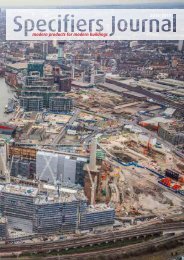Specifiers Journal 2015-2016
Specifiers Journal 2015-2016
Specifiers Journal 2015-2016
You also want an ePaper? Increase the reach of your titles
YUMPU automatically turns print PDFs into web optimized ePapers that Google loves.
Building an effective security plan<br />
As the construction industry begins to flourish postrecession,<br />
demand for construction site security<br />
looks set to rise. Amanda Caton of the British Security<br />
Industry Association explores the changing security<br />
requirements of construction sites and highlights<br />
best practice in security procurement.<br />
The construction sector has<br />
experienced a positive start to <strong>2015</strong>,<br />
with figures from the Office for<br />
National Statistics (ONS) suggesting<br />
that the sector has contributed to<br />
a better than expected outlook for<br />
economic growth in the first quarter<br />
of the year. Making up 6.4% of the<br />
UK’s economy, the construction sector<br />
suffered the effects of recession<br />
particularly keenly, but is now<br />
beginning to feel more upbeat, with<br />
reports suggesting that customer<br />
uncertainty has reduced following the<br />
General Election 1 .<br />
So, how might these changes affect<br />
demand for construction site security?<br />
As the number of construction<br />
projects rise, it is natural to expect<br />
demand for effective site security<br />
measures to increase in tandem. With<br />
the typical building site playing host<br />
to a number of different contractors<br />
at any one time, as well as a wide<br />
range of valuable equipment, security<br />
considerations are always paramount,<br />
especially given the often open and<br />
accessible nature of construction<br />
sites. Left vulnerable overnight,<br />
construction sites face the biggest<br />
threat from theft, vandalism and<br />
terrorism.<br />
A security breach or poorly<br />
implemented security measure<br />
can have a number of negative<br />
effects on a construction site<br />
or depot. These can include<br />
financial losses and unplanned<br />
downtime, along with health<br />
and safety issued cause by<br />
unauthorised tampering of<br />
equipment or procedures.<br />
Therefore, site security is<br />
essential to the successful<br />
and timely completion of<br />
a project, or the continued<br />
success of a business. As such,<br />
security should be addressed<br />
at the earliest opportunity,<br />
ensuring maximum protection<br />
throughout the entire<br />
construction process.<br />
An holistic approach<br />
A layered approach to security works<br />
best to protect such sites. Starting at<br />
the perimeter and working inward,<br />
various security measures – both<br />
electronic and physical – can integrate<br />
successfully to provide an holistic,<br />
effective solution to securing even the<br />
most complex of construction sites.<br />
According to construction industry<br />
intelligence analysts, Glenigan 2 ,<br />
London is leading the way in the<br />
market’s recovery, with rising<br />
demand for office accommodation<br />
set to prompt increased investment<br />
in the development of prime office<br />
space, while the sharp rise in planning<br />
approvals for a number of high-profile<br />
residential schemes also looks set to<br />
provide the market with a boost.<br />
Of course, one of the most highprofile<br />
building projects in the capital<br />
is Europe’s largest construction<br />
project, Crossrail, which employs<br />
10,000 workers across 40 sites as the<br />
project continues to work towards<br />
its goal of constructing 42 additional<br />
kilometres to London’s railway<br />
network, providing a more direct<br />
route across the city. Started in 2008<br />
and scheduled for final completion in<br />
2018, much of the work on the project<br />
is due to take place in the <strong>2015</strong>-16<br />
period.<br />
Interviewed recently<br />
by IFSECGlobal 3 .com, Crossrail’s<br />
Security Manager, David Buck,<br />
outlined the successful application<br />
of the layered security approach that<br />
has been deployed at Crossrail sites<br />
across the city. Showcasing the busy<br />
Farringdon site, near the heart of<br />
the city, David explained the blend<br />
of physical perimeter security with<br />
electronic security measures and<br />
manned guarding:<br />
“You will see hoarding, you will see<br />
gates, you’ll see entry points, and all<br />
of these are the physical ‘locks and<br />
bolts’ of how a site is secured. On<br />
top of that, we will then introduce an<br />
electronic system of Access Control,<br />
which will allow you access through<br />
turnstiles, and then internally, we<br />
6 SPECIFICATION JOURNAL <strong>2015</strong>-<strong>2016</strong>








